It’s just past 3 a.m. and the nuns on kitchen duty at Dolma Ling Nunnery in northern India are already hard at work boiling water and heating up griddles to prepare breakfast for about 280 nuns and staff.

In the shelter of the cowshed, the nunnery’s small herd of dairy cows are still asleep. The nuns will milk them around 6:30 a.m. and carry their sweet, fresh milk in pails to the kitchen, where it will be used to make both traditional Tibetan butter tea and Indian-style sweet tea.
In this blog post we’d like to take you behind the scenes at some of the seven nunneries in northern India supported through the Tibetan Nuns Project. We offer profound thanks to our sponsors of nuns whose generosity feeds over 700 nuns every day.
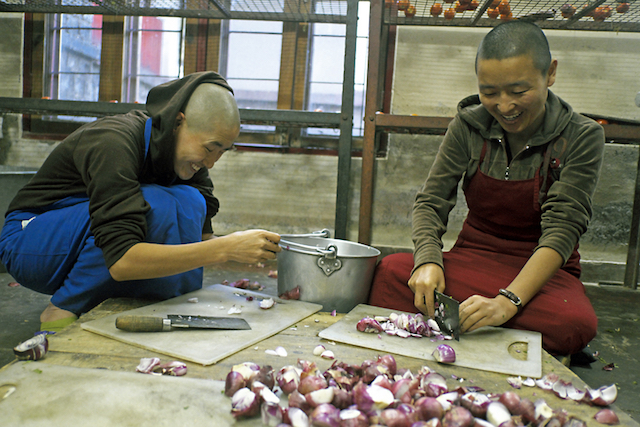
Chopping vegetables for about 280 people is a big job at Dolma Ling. The nuns take turns on kitchen duty. This photo and the above kitchen photo are courtesy of Brian Harris.
For 2,500 years, since the time of the Buddha, nuns and monks have relied on the generous support of the lay community for their daily food. The practice of generosity (dana) is the first of the perfections or paramitas in both Mahayana and Theravada Buddhism. Offering food to monastics is a meritorious act. As Milarepa, the great Tibetan yogi and poet, said, “The practitioner and benefactor offering food create the cause to achieve enlightenment together.”
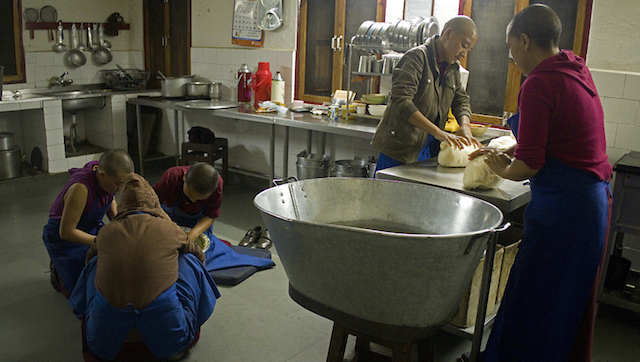
It’s long before dawn when the nuns assemble in the kitchen to start preparing breakfast. Meals are prepared collectively in the nunnery kitchens. Photo courtesy of Brian Harris.
In countries like Thailand, where Theravada Buddhism is practiced, monks and nuns go on daily alms rounds, carrying their alms bowls and accepting offerings of food from the local community.
In the nunneries supported by the Tibetan Nuns Project, the Tibetan nuns work together to prepare food for the entire nunnery. While the nunneries do their best to be self-sufficient, all of them are still heavily reliant for food on the support they receive through our sponsorship program and through general donations to the Tibetan Nuns Project.
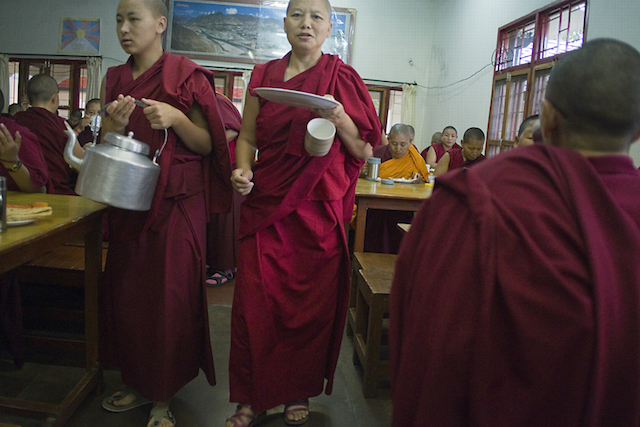
At Dolma Ling, a high-pitched gong sounds three times a day to announce meals. The senior nuns enter the dining hall first, while the younger nuns, holding their bowls, cups, and spoons, wait their turn. Photo courtesy of Brian Harris.
All the nunneries follow a simple vegetarian diet. Breakfast might be a piece of flat bread, cooked mixed vegetables, and tea. Lunch is the main meal of the day and is often rice, two kinds of vegetables, dal, and sometimes fruit. Dinner is often a noodle soup and maybe a steamed bun.

It takes a lot of vegetables to feed about 250 nuns. As part of last year’s completion of the new kitchen at Dolma Ling, the nuns were able to build an enclosed vegetable storage and chopping area to keep birds and animals out.
Good health and nutrition are essential for the nuns to be able to study; it is literally food for thought. The majority of nuns are refugees from Tibet and most arrived in India destitute, malnourished, and ill. As refugees without their families and traditional communities to support them, they rely more than ever on the compassion and generosity of others. Providing the nuns with a steady supply of food makes a dramatic difference in the energy they are able to devote to their studies. By giving food, you are also helping to preserve the dharma and maintain Tibet’s unique Tibetan culture and religion.
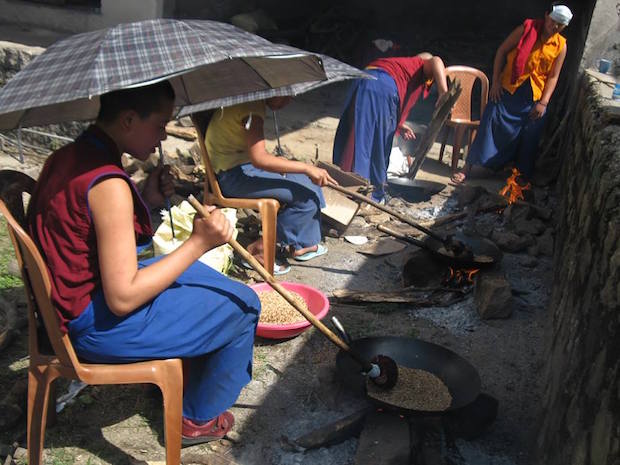
Nuns from Shugsep Nunnery prepare tsampa by roasting barley and then grinding it into flour. Tsampa is a staple of the Tibetan diet and is mixed with butter tea. There’s a tradition of throwing pinches of tsampa in the air during many Tibetan Buddhist rituals.
Food at Remote Nunneries
The nuns in remote nunneries in arid landscapes, such as Sherab Choeling Nunnery in Spiti and Dorjee Zong in Ladakh, have difficult living conditions. They often face long, harsh winters and sometimes heavy snowfalls that cut off their access to neighboring villages. The nuns must stock up on supplies of food and cooking fuel well before the onset of cold weather.
At Sherab Choeling Nunnery in the high-altitude Spiti Valley, the nuns work hard during the summer months to grow food for the long winter. The people in a nearby village gave the nuns a plot of land where they can grow spinach, beans, and potatoes. The head nun also donated her share of a field to the nunnery, so the nuns are able to grow peas and wheat.

The simple kitchen at Sherab Choeling Nunnery is one of the warmest parts of the nunnery in winter. During the coldest months, the nuns hold their classes, prayers, and meetings in the kitchen because it is warmer and helps to save wood.
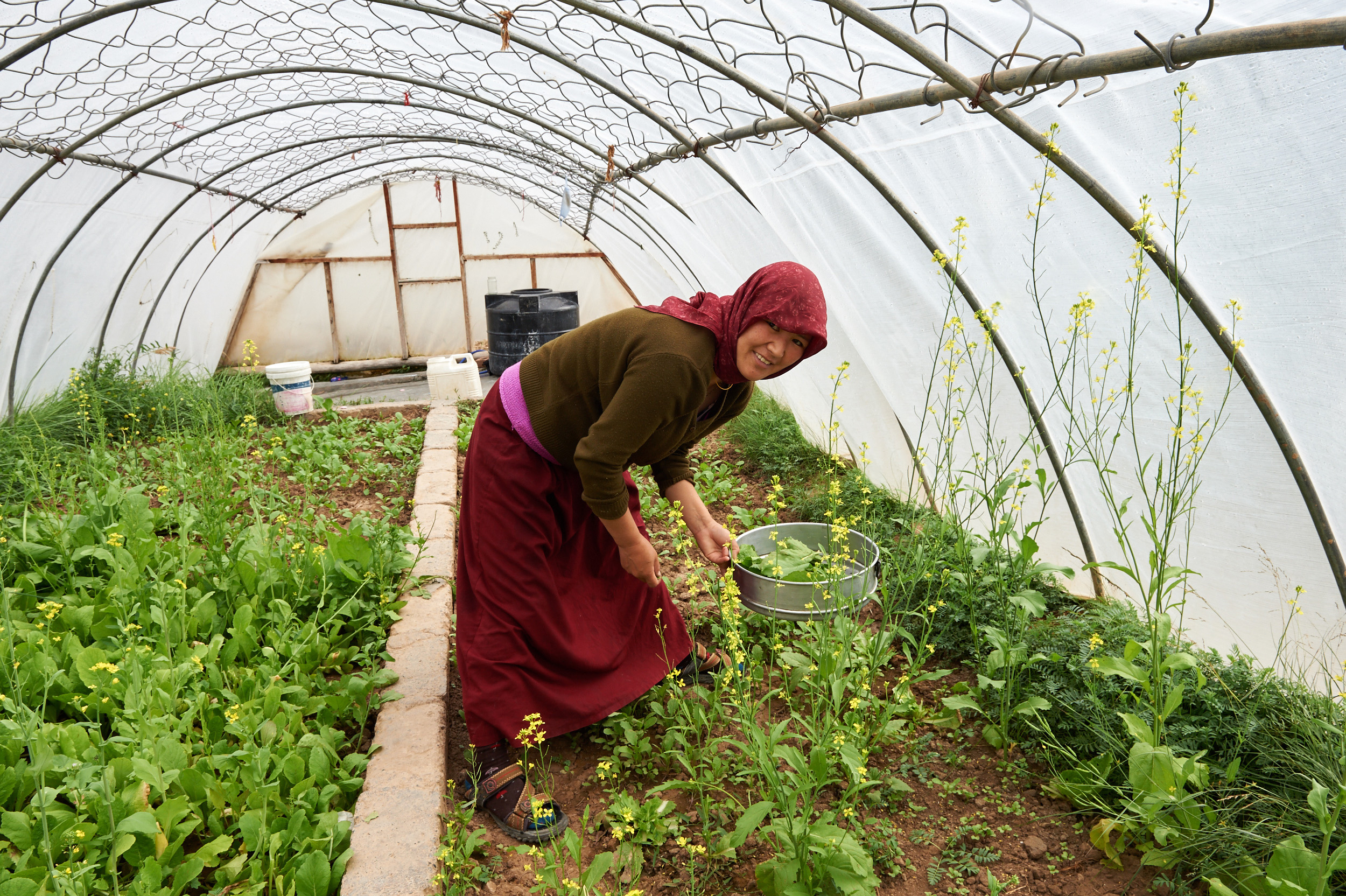
The nuns at Sherab Choeling Nunnery in Indian Himalayas have three greenhouses where they mostly grow spinach. Photo courtesy of Olivier Adam.
Recipes
In past blog posts, we’ve shared recipes for some of the typical dishes that the nuns eat such as:
How you can help feed the nuns
The best way to donate food to the nuns at the seven nunneries we support is to sponsor a nun. For about $1 a day, you can help provide the nuns with food, education, shelter, clothing, and medical care. Learn more at https://tnp.org/youcanhelp/sponsor/
If you are unable to commit to a sponsoring a nun, please consider becoming a monthly donor at any amount you choose.
As Constance, one of our donors, wrote, “From a Tibetan Buddhist perspective, there is no greater virtuous effort than supporting those who dedicate themselves to studying and teaching the path to ‘awakening’.”
Thank you!
